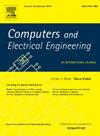Enhancing the performance of graphene and LCP 1x2 rectangular microstrip antenna arrays for terahertz applications using photonic band gap structures
IF 4
3区 计算机科学
Q1 COMPUTER SCIENCE, HARDWARE & ARCHITECTURE
引用次数: 0
Abstract
The terahertz (THz) frequency band (0.1–10 THz) has drawn a lot of attention due to the growing demand for greater resolutions, lower latency, faster data rates, and wider bandwidth in 6 G technologies. This range provides data speeds exceeding tens of gigabits per second, large bandwidth, great spectral resolution, and non-ionizing characteristics. THz signals have potential; however they are affected by attenuation, route losses, and atmospheric conditions, necessitating the use of specialised antenna designs. This work presents a 300 GHz rectangular microstrip patch antenna with Graphene as the patch material and Liquid Crystal Polymer (LCP) as the substrate. Photonic band gap (PBG) substrates are used to incorporate cuboid and cylindrical air gaps in square and triangular lattices, hence improving performance. The highest performance is found with cylindrical air gaps in a triangular lattice PBG substrate, which has a bandwidth of 29.56 GHz, a return loss of –48.12 dB, a gain of 10.4 dBi, a directivity of 10.8 dBi, and a radiation efficiency of 91 %. These results establish the proposed antennas as highly effective for broadband and high-speed THz applications, particularly in 6 G systems like advanced sensing applications, ultra-fast device-to-device (D2D) communications, potential beam steering applications, and non-invasive imaging solutions.
利用光子带隙结构提高太赫兹应用中石墨烯和 LCP 1x2 矩形微带天线阵列的性能
由于 6 G 技术对更高分辨率、更低延迟、更快数据传输速率和更宽带宽的需求日益增长,太赫兹(THz)频段(0.1-10 THz)引起了广泛关注。这一范围的数据传输速率超过每秒数十吉比特,带宽大,频谱分辨率高,并且具有非电离特性。太赫兹信号具有潜力,但会受到衰减、路由损耗和大气条件的影响,因此必须使用专门的天线设计。这项研究提出了一种 300 GHz 的矩形微带贴片天线,采用石墨烯作为贴片材料,液晶聚合物(LCP)作为衬底。光子带隙(PBG)衬底用于在方形和三角形晶格中加入长方体和圆柱形气隙,从而提高性能。三角形晶格 PBG 衬底中的圆柱形气隙性能最高,其带宽为 29.56 GHz,回波损耗为 -48.12 dB,增益为 10.4 dBi,指向性为 10.8 dBi,辐射效率为 91%。这些结果表明,所提出的天线对宽带和高速太赫兹应用非常有效,特别是在 6 G 系统中,如先进传感应用、超高速设备对设备 (D2D) 通信、潜在的波束转向应用和非侵入式成像解决方案。
本文章由计算机程序翻译,如有差异,请以英文原文为准。
求助全文
约1分钟内获得全文
求助全文
来源期刊

Computers & Electrical Engineering
工程技术-工程:电子与电气
CiteScore
9.20
自引率
7.00%
发文量
661
审稿时长
47 days
期刊介绍:
The impact of computers has nowhere been more revolutionary than in electrical engineering. The design, analysis, and operation of electrical and electronic systems are now dominated by computers, a transformation that has been motivated by the natural ease of interface between computers and electrical systems, and the promise of spectacular improvements in speed and efficiency.
Published since 1973, Computers & Electrical Engineering provides rapid publication of topical research into the integration of computer technology and computational techniques with electrical and electronic systems. The journal publishes papers featuring novel implementations of computers and computational techniques in areas like signal and image processing, high-performance computing, parallel processing, and communications. Special attention will be paid to papers describing innovative architectures, algorithms, and software tools.
 求助内容:
求助内容: 应助结果提醒方式:
应助结果提醒方式:


